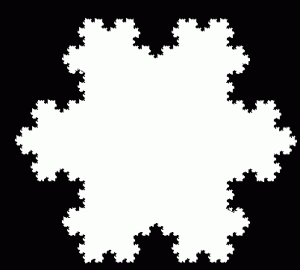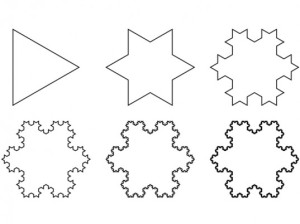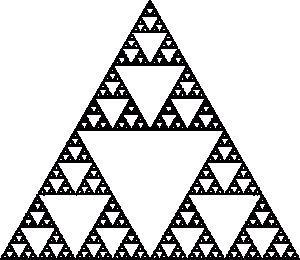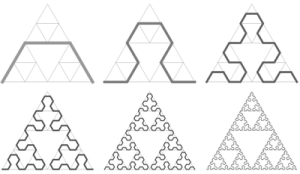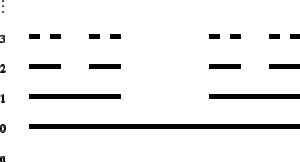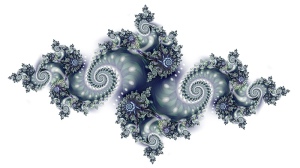Koch Snowflake
The Koch Snowflake is a geometric fractal (fractal produced by self-similar geometric manipulations)
This problem was made by taking an equilateral triangle and dividing each of the three sides into three equal segments, then placing another equilateral triangle facing outward with the base forming each middle segment. The middle segment is then removed. This process is continued and can be contented infinitely.
The below diagram shows how the Koch Snowflake is formed, starting from a single equilateral triangle
Sierpinski Triangle
The Sierpinski Triangle is one of the most well known and familiar fractals. It is also a geometric fractal (like the Koch Snowflake). Also, both the Koch Snowflake and the Sierpinski triangle use an equilateral triangle as the base.
This fractal is made by starting with an equilateral triangle, and connecting the midpoints of each of the sides to form 4 corresponding equilateral triangles. This process is then repeated for each of the triangles, and each of those triangles, and so on, creating the shape shown above. The first 4 iterations of this process are shown below.
Sierpinski Curve
The Sierpinski Curve is a base-motif fractal that looks exactly like the Sierpinski Triangle after an infinite number of iterations. The base for the curve is a straight line at each iteration, the lines are replaced by the motif.
Because the Sierpinski Curve is a sweep fractal, the motif is flipped for every other segment before the substitution. Although the curve clearly has two endpoints, the sum of the lengths of the segments forming the fractal is infinite. This is because the motif is 1.5 times longer than the base, which makes the fractal infinitely long after infinite number of iterations.
Cantor set
The cantor set was a mathematical concept that was introduced by the German mathematician Georg Cantor in 1883. This the first Mathematical Monster that I personally encountered, the cantor set starts out as a set of infinite points on a line segment, but with the recursive subtraction of the middle third of each line segment, it eventually becomes more sparse. During the 1980s at IBM, such concepts as the cantor set demonstrated real world applicability when a wide range of disruptive frequencies prevented the transmission of computer data over telephone lines. When simulating the frequencies to generate this noise, mathematicians such as Mandelbrot discovered that within these frequencies there were other smaller frequencies of the same form. This self-similarity only meant one thing — fractals were responsible.
Julia Set
The Julia set is a set of complex numbers. It is far more complicated than the other fractal mentioned above. It is one of those fractals that cannot be described as a base motif fractal. The Julia set it created by plotting the elements of the set on the complex plane. As with many other fractals the Julia set is often depicted with bright colourings. The colouring is not part of the definition of the fractal. Julia sets are named after Gaston Julia. He was a French mathematician who discovered Julia sets and first explored their properties.

